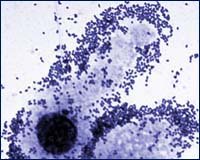I am interested in the molecular mechanisms of microbial pathogenesis, particularly in the mechanisms which allow colonization and carriage of Bordetella pertussis. B. pertussis is the Gram-negative bacterium that causes whooping cough (pertussis). The pathogenesis of B. pertussis is not completely understood, and questions about carriage in adults (the reservoir) and the long-term efficacy of the new acellular pertussis vaccines have yet to be adequately addressed. We are currently experiencing resurgence in pertussis. The reason for this is not known.
My laboratory seeks to:
1. understand the mechanisms by which B. pertussis colonizes (vaccinated) individuals,
2. elucidate the mechanisms by which the BrkA protein, a key mediator of B. pertussis’ resistance to complement-dependent killing, is secreted by the bacterium, and
3. develop tools to perform whole genome analyses of B. pertussis in order to track emerging strains.
B. pertussis colonization
 We are currently studying a virulence factor of B. pertussis called BrkA. BrkA protects the bacterium from an antibody-dependent lytic attack by the complement system, suggesting that it may be important in enabling carriage of B. pertussis in a previously immune individual. Interestingly, we have shown that antibodies to BrkA are capable of neutralizing BrkA and can thus potentiate the intrinsic capacity of immune serum to kill B. pertussis. BrkA also contributes to the ability of B. pertussis to bind to host cells. As such, it is one of many B. pertussis adhesins and it is not known what role these adhesins play in the pathogenesis of pertussis. We are (i) elucidating the molecular mechanisms by which BrkA protects B. pertussis, (ii) identifying the protective domain(s) of BrkA, and (iii) characterizing BrkA’s mechanism of adherence.
We are currently studying a virulence factor of B. pertussis called BrkA. BrkA protects the bacterium from an antibody-dependent lytic attack by the complement system, suggesting that it may be important in enabling carriage of B. pertussis in a previously immune individual. Interestingly, we have shown that antibodies to BrkA are capable of neutralizing BrkA and can thus potentiate the intrinsic capacity of immune serum to kill B. pertussis. BrkA also contributes to the ability of B. pertussis to bind to host cells. As such, it is one of many B. pertussis adhesins and it is not known what role these adhesins play in the pathogenesis of pertussis. We are (i) elucidating the molecular mechanisms by which BrkA protects B. pertussis, (ii) identifying the protective domain(s) of BrkA, and (iii) characterizing BrkA’s mechanism of adherence.
BrkA secretion
 BrkA is secreted by a mechanism where its own carboxy terminus forms a channel in the bacterial outer membrane through which the rest of the protein is extruded. This mechanism of secretion is called autotransport (or Type V secretion) and it represents an efficient means to display large proteins on the surface of Gram negative bacteria. We have shown that the C-terminus of BrkA is capable of forming a channel in a model membrane system. The size of the channel suggests that the displayed proteins are exported in a partially unfolded translocation-competent state. We have recently identified a putative intramolecular chaperone region that promotes folding of BrkA likely either during translocation, or shortly after it emerges from its transporter domain. We have identified this folding domain in a large family of autotransporter proteins that represents a variety of virulence factors from different Gram-negative bacterial pathogens.
BrkA is secreted by a mechanism where its own carboxy terminus forms a channel in the bacterial outer membrane through which the rest of the protein is extruded. This mechanism of secretion is called autotransport (or Type V secretion) and it represents an efficient means to display large proteins on the surface of Gram negative bacteria. We have shown that the C-terminus of BrkA is capable of forming a channel in a model membrane system. The size of the channel suggests that the displayed proteins are exported in a partially unfolded translocation-competent state. We have recently identified a putative intramolecular chaperone region that promotes folding of BrkA likely either during translocation, or shortly after it emerges from its transporter domain. We have identified this folding domain in a large family of autotransporter proteins that represents a variety of virulence factors from different Gram-negative bacterial pathogens.
Whole-genome display
 In collaboration with Dr. Wan Lam at the BC Cancer Agency, we have begun to develop a two-dimensional DNA display technology to perform comparative and functional genomics of B. pertussis and other bacteria. This technology represents a high-resolution method with the potential for tracking outbreak strains. This work has led to the development of a tool called Bacterial Comparative Genomic Hybridization (BCGH) for directly identifying lateral gene transfer.
In collaboration with Dr. Wan Lam at the BC Cancer Agency, we have begun to develop a two-dimensional DNA display technology to perform comparative and functional genomics of B. pertussis and other bacteria. This technology represents a high-resolution method with the potential for tracking outbreak strains. This work has led to the development of a tool called Bacterial Comparative Genomic Hybridization (BCGH) for directly identifying lateral gene transfer.


